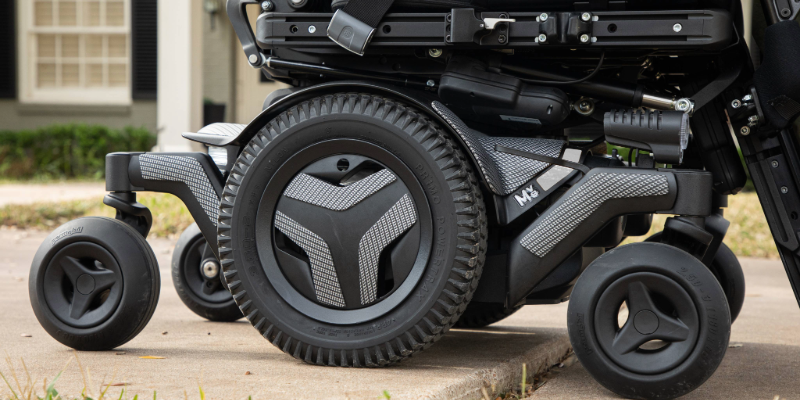When we think of suspension in power wheelchairs, many of us picture springs and shock absorbers designed to reduce vibration. While that’s partly true, suspension systems are far more complex and their impact on function, especially for users with complex needs, is profound.
What Is Suspension, Really?

Suspension in a power wheelchair refers to the system that manages how the base responds to uneven terrain. It includes:
- Springs and dampers absorb and dissipate energy from bumps and jolts.
- Tyres and inflation absorb energy and assists in maintaining ground contact.
- Linkages allow the wheels to move independently, maintaining ground contact.
- Drive wheel configuration. Mid-wheel, front-wheel, and rear-wheel drives all interact differently with suspension systems and impact vibration experienced by users. Mid-wheel drive power wheelchairs have six wheels, whilst front-wheel drive has four wheels.
- Chassis design and weight distribution influences how forces are transferred through the system.
All these components work together to determine how the wheelchair navigates curbs, ramps, cracks in the pavement, different types of terrain, carpets, and transitions between surfaces. They also play a key role in shaping the comfort, experience, and functional impact for the person using the chair.
Why Suspension Matters for Function
For individuals who use wheelchairs, suspension isn’t just about comfort—it’s about function, safety, and participation.
- Fatigue Reduction: poor suspension increases whole-body vibration, which can lead to fatigue over time. A smoother ride means users can stay out longer and engage more fully in daily activities. It may also impact a user’s seating tolerance.
- Postural Stability: effective suspension helps maintain consistent seating angles and reduces jarring movements that can disrupt positioning which is critical for users with limited trunk control or tone abnormalities, or for users with complex seating needs.
- Pain Management: repeated exposure to vibration and jolts can exacerbate musculoskeletal pain. Suspension helps mitigate this, especially for users with chronic pain or joint conditions.
- Community Access: navigating curbs, uneven footpaths, and public transport becomes safer and more predictable with a well-designed suspension system. This may directly support independence and community participation. Suspension is not just about vibration management, but also road handling, traction and stability.
Suspension Considers when Prescribing Power Wheelchairs
There are many power wheelchairs on the market, each with different features and designs. To assist in narrowing down which power wheelchair may assist a user achieve their goals, consider how suspension (too much or too little) may impact sitting tolerance, posture, pain, community access, and participation across all environments throughout the entire day. It’s important to think beyond just whether a user can sit comfortably—also consider if the wheelchair can climb obstacles, maintain traction, and stay stable across all the environments they encounter every day.
Consider some of the following questions in your clinical reasoning process when considering suspension:
- How does the user’s environment challenge their mobility?
- Are they more sensitive to vibration or instability, and what impact does this have on their function and participation?
- Will improved handling and stability reduce fatigue or pain, or even increase community access and participation?
- Are there environments which the current chair is unable to climb, maintain stability or traction?
- If a sales representative says that a power wheelchair has “good suspension”, ask follow up questions such as why? What makes it good, what are the components and how does it compare to other chairs?
Understanding suspension as a dynamic system and not just a spring can help you better match technology to your client’s real-world needs. If you are curious on how to compare the suspension of chairs, have a look at our 3 Series vs 5 Series clinical guide. In this guide we discuss the suspension differences and the potential functional impact these differences may have on individuals.
References:
Wolf, E., Cooper, R.A., Pearlman, J., Fitzgerald, S.G. and Kelleher, A. (2007). Longitudinal assessment of vibrations during manual and power wheelchair driving over select sidewalk surfaces. The Journal of Rehabilitation Research and Development, 44(4), p.573. doi:https://doi.org/10.1682/jrrd.2006.05.0049.
Reza N. Jazar (2008). Vehicle Dynamics: Theory and Applications. Spring. p. 455. Retrieved 2012-06-24.
International Standards Organization (ISO). ISO 2631-1: Mechanical vibration and shock – Evaluation of human exposure to whole-body vibration – Part 1: General requirements. Geneva (Switzerland): International Standards Organization; 1997.
www.resna.org. (n.d.). The Effect of Whole body vibration on Power wheelchair mobility: a focus group. [online] Available at: https://www.resna.org/sites/default/files/conference/2015/wheeled_mobility/degiovine.html [Accessed 30 March. 2022]
Garcia-Mendez, Y., Pearlman, J.L., Boninger, M.L. and Cooper, R.A. (2013). Health risks of vibration exposure to wheelchair users in the community. The Journal of Spinal Cord Medicine, 36(4), pp.365–375. doi:10.1179/2045772313y.0000000124.
Pettersson, T (2006). The effect of an outdoor powered wheelchair on activity and participation in users with stroke The effect of an outdoor powered wheelchair on activity and participation in users with stroke. October. https://doi.org/10.1080/1748310060075784

Tilly Brook, MOccThy (Hons) (OT)
Director Clinical Services
Tilly Brook graduated from the University of Adelaide in 2008 with a Bachelor of Health Science followed by a Masters of Occupational Therapy (Hons) in 2010 from the University of Sydney. Tilly worked within rehabilitation, working primarily with adults with a brain injury until 2015 when she moved to Singapore. In Singapore, she worked with children and adults at the Cerebral Palsy Alliance School (CPAS). In 2017 Tilly’s clinical knowledge continued as she worked with Mobility Solutions in Auckland, New Zealand. On her return to Australia, Tilly assisted in the development of the Clinical Hub Team at Sunrise Medical where her passion and experience for mentoring and educating therapists grew. Tilly Joined Permobil in January 2022 and is driven to grow therapists, enabling them to be the best therapist they can be.
